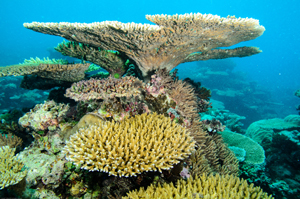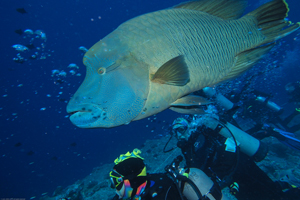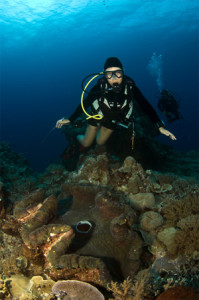 For a scuba diving enthusiast, the Micronesian Republic of Palau is near, if not at, the top of their lifelong “bucket list.” It is a 100-mile long archipelago, with six small groups of islands surrounded by a reef in the middle of the western Pacific Ocean. The majority of these are the world famous, and uninhabited, Rock Islands.
For a scuba diving enthusiast, the Micronesian Republic of Palau is near, if not at, the top of their lifelong “bucket list.” It is a 100-mile long archipelago, with six small groups of islands surrounded by a reef in the middle of the western Pacific Ocean. The majority of these are the world famous, and uninhabited, Rock Islands.
Palau is an exceptional destination for the adventurous soul. Foremost are the pristine reefs and over 100 dive locations teeming with a wildly diverse array of marine life. It also has an interesting cultural history, dating back to 1,000 BC when the first inhabitants arrived from Indonesia. My primary interest revolved around actions that occurred during World War II when Palau was used as a major base by the Japanese until the US captured it in a vicious fight in September 1944. In recent years, East Asian tourists come for a brief vacation to get a tan on the beach or have a tropical wedding. 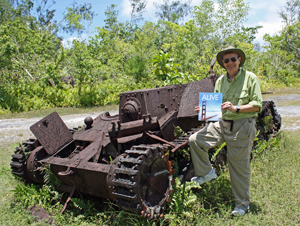
My wife Jennifer and I decided 2013 was the year to check this one off our list. However, just locating Palau on a map is not a simple task, while getting there involves many hours of flying. Fortunately, her brother, David, and his wife, Judi, had been there before and coordinated the process. In the end, we made arrangements for a special two week liveaboard cruise on the M/V Tropic Dancer, a very comfortable catamaran dive boat with an excellent Captain and crew.
After our 18 divers boarded the boat in Koror, we steamed leisurely north to some rarely explored locations. On most days there were four one-hour dives. The the first one began around 7:15am and sometimes, the last one would be at sunset. The water temperature was roughly 83 degrees so we were able to wear relatively thin wetsuits, which allowed great freedom of movement for taking pictures or swimming with larger fish that came our way. While Palau is prized by scuba divers, I snorkeled the entire time and enjoyed hanging out on the shallow reef tops.
Over the course of two weeks, as our boat wandered from north to south, we visited a wide variety of sites including steep walls, pristine tropic reefs, deep caves and complex tunnels. One of the most famous dive sites in the world is called Blue Corner, a wall that juts out into deep water. It has a rich concentration of marine life including an abundance of grey reef sharks, barracudas, sea turtles, napolean wrasse, humphead parrotfish and manta rays. At times, it looked like an underwater movie set with all the camera flashes popping off! German Channel and Peleliu Express are two other world-famous dive sites that provide an amazing experience, even for the veteran diver. Of course, the southern-most island in the group is Peleliu, where a significant WWII battle was fought, so there were numerous aircraft and ship wrecks to investigate and photograph.
It is impossible to describe the number, color and types of marine life we encountered. Each day was filled with many wondrous sights, from the large pelagic cruising near us all the time, to cute little clown fish, hovering over their home anemone. There was a fantastic display of soft and hard corals as well as reef dwelling creatures like moray eels, and giants clams with shockingly blue mantles. Two favorites of mine were the royal blue starfish and clown triggerfish found in the shallower water.
When the current got too strong for free swimming, divers would place a small hook into the reef and hover in one place while the sea life came rushing by on the undersea tide. On one such occasion, a 20-minute long school of bream (many thousands) zoomed by, transiting through Palau on their way from the Philippine Sea to the Pacific Ocean. On another occasion, we visited a manta ray cleaning station, where small wrasses and butterfly fish entered the manta’s mouth to eat various parasites in there.
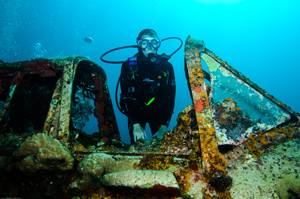 We also did a land tour of the island of Peleliu one day and visited some of the key WWII battle sites. In addition to exploring the invasion beach and the airfield we spent time in a huge cave that once housed 1,000 Japanese military personnel. Many of the artifacts left over from the war (tanks, landing craft, aircraft, heavy guns, etc.) are slowly being reclaimed by the jungle but there is enough still available to make the visit interesting and educational. Our boat was moored in a small mangrove-lined lagoon not far from the home of a large saltwater crocodile. Needless to say, none of us swam to shore that day.
We also did a land tour of the island of Peleliu one day and visited some of the key WWII battle sites. In addition to exploring the invasion beach and the airfield we spent time in a huge cave that once housed 1,000 Japanese military personnel. Many of the artifacts left over from the war (tanks, landing craft, aircraft, heavy guns, etc.) are slowly being reclaimed by the jungle but there is enough still available to make the visit interesting and educational. Our boat was moored in a small mangrove-lined lagoon not far from the home of a large saltwater crocodile. Needless to say, none of us swam to shore that day.
The final day proved to be a very unique and rewarding event in its own way. Jellyfish Lake is a marine lake located within the world famous Rock Islands, a group of small, rocky, mostly uninhabited islands in Palau’s Southern Lagoon. Of the 70 marine lakes in the area, Jellyfish Lake is the most famous and the only one open to tourists. It is about 12,000 years old and is notable for the millions of golden jellyfish that migrate across the lake every day.
Although the jellyfish living in the lake have stinging cells (nematocytes), their potency has lessened over many generations and rarely causes harm to humans. I can personally attest, however, that it is possible to feel the stings on sensitive areas, albeit very mild. People with allergies to jellyfish should consider wearing protective clothing for their swim, such as a rash guard or dive skin.
Each day, roughly four million golden jellyfish pulse through the water in rhythmic motion.Their bodies rotate counter-clockwise as they swim to the surface, presumably to provide even exposure to the sun for the symbiotic algae in their bodies.
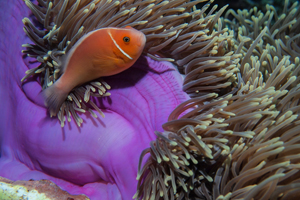 To reach the lake from the main boat dock, we had to endure short hike over a ridge that separates the lake from the ocean lagoon. Upon arrival, we saw a massive number of jellyfish milling around, vying for their place in the sun on its journey from east to west across the sky. Jumping into the water to join them for a brief snorkel/swim require a test of faith, since virtually all humans who have ever played at the beach during summer vacation have been painfully stung by a jellyfish at least once.
To reach the lake from the main boat dock, we had to endure short hike over a ridge that separates the lake from the ocean lagoon. Upon arrival, we saw a massive number of jellyfish milling around, vying for their place in the sun on its journey from east to west across the sky. Jumping into the water to join them for a brief snorkel/swim require a test of faith, since virtually all humans who have ever played at the beach during summer vacation have been painfully stung by a jellyfish at least once.
Most of our group “took the plunge,” but only a few of us swam slowly into the throng of reddish/brown jellyfish. We had to swim very carefully to ensure we didn’t damage their delicate bodies, especially with our fins. Even then, on occasion, we felt a little claustrophobic when a particularly large group completely surrounded us as they pulsed along on their migration path. In order to not hurt them we could only tread water and wait for the throng to pass.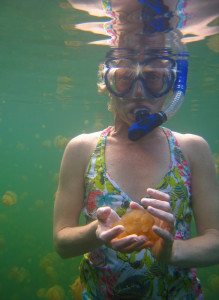
At one point, Jennifer and I each gently held a jellyfish in our hands, much as one would hold a small kitten. They really do feel like holding an undulatingbatch of jello!It was a truly amazing experience – one we highly recommend for anyone wishing to get closer to the miracles of nature.
Photos Courtesy David & Judi Willis

